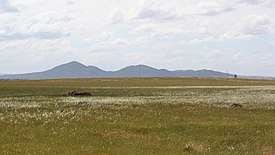You Yangs
| You Yangs | |
|---|---|
| Wurdi Youang | |

The You Yangs viewed from the south, with Avalon Airport in the foreground
|
|
| Highest point | |
| Peak | Flinders Peak |
| Elevation | 319 m (1,047 ft) |
| Dimensions | |
| Length | 24 km (15 mi) |
| Geography | |
| Country | Australia |
| State/Province | Victoria |
| Range coordinates | 37°57′S 144°26′E / 37.950°S 144.433°ECoordinates: 37°57′S 144°26′E / 37.950°S 144.433°E |
| Geology | |
| Age of rock | Devonian |
| Type of rock | Igneous, Sedimentary and Metamorphic |
The You Yangs are a series of granite ridges that rise to 319m (Flinders Peak) above the Werribee Plain approximately 55 km south-west of Melbourne and 22 km north-east of Geelong, in Victoria, Australia. The main ridge runs roughly north–south for about 9 km, with a lower extension running for about 15 km to the west. Much of the southern parts of the ranges are protected by the You Yangs Regional Park.
Although only 319 m at their highest, they dominate the landscape and are clearly identifiable from nearby Geelong, Melbourne and beyond. Camping is not permitted in the You Yangs. The foothills to the north of the peaks are home to Ford Australia's proving ground.
The You Yangs are also the home of a Geoglyph constructed by the Australian artist Andrew Rogers in recognition of the indigenous people of the area. It depicts Bunjil, a mythical creature to the local Wathaurong Aboriginals. This geoglyph has a wing span of 100 metres and 1500 tonnes of rock was used to construct it, and was unveiled in March 2006.
The name "You Yang" comes from the Aboriginal words Wurdi Youang or Ude Youang which could have any number of meanings from "big mountain in the middle of a plain", "big or large hill", or "bald". The Woiwurrung word for granite stone 'yow.wong' is also a possibility. The Yawangi people probably enlarged natural hollows in the rocks to form wells that held water even in dry seasons.
Explorer Matthew Flinders was the first European to visit the You Yangs. On 1 May 1802, he and three of his men climbed to the highest point. He named it "Station Peak" but the name was changed in 1912 to "Flinders Peak" in his honour.
...
Wikipedia
